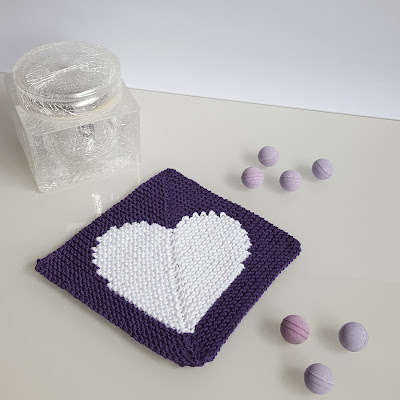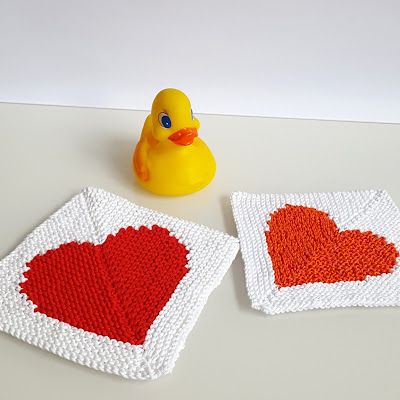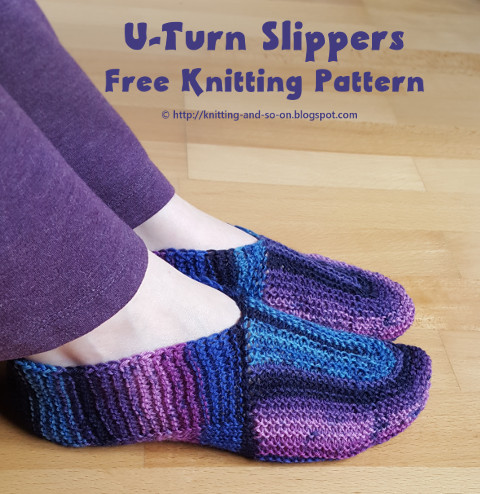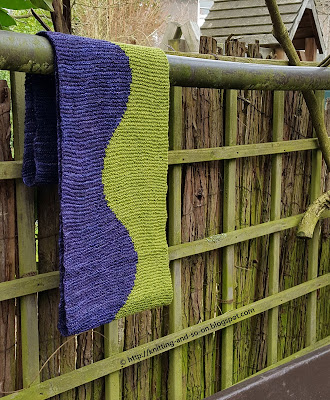It's a fun project that can be finished within a few hours with a gorgeous heart effect. It's great if you want to learn a new technique, like short rows or intarsia.
Eine deutsche Version dieser Anleitung gibt es hier.
A german version of this pattern can be found here.

This work by Knitting and so on is licensed under a Creative Commons Attribution-NonCommercial-ShareAlike 4.0 International License.

Materials
- about 30 - 40 grams of cotton yarn in two colors (called C1 and C2) - I used some old yarn that I think was Aran weight
- needles that the yarn calls for - I used 4mm dpns
Size
The size depends on the yarn you use. The first I did (in Sport weight, with 3mm needles) measured 14 cm by 14 cm. The second one (Aran weight) measured 17 cm by 17 cm.
If you want to know beforehand, how big the piece is going to be cast on 32 sts and knit a few rows in garter stitch. The width you can measure now will be the finished piece's width and height.
Techniques and Notation
- Intarsia: Changing colors with the intarsia technique - as shown in this YouTube video by knitwithpat; or this YouTube video by Francoise Danoy.
- Short rows with wrap and turn (w+t) - as shown in this YouTube video by Very Pink Knits.
Since this washcloth is knit in garter stitch, you don't have to pick up your wraps - except in two rows, i.e. the rows where the wrapping color is different from the color of the wrapped stitch. These rows are indicated in the pattern. Here's a YouTube video that shows how to pick up your wraps (also by Very Pink Knits). - Throughout the pattern, the following notation will be used: C1 (k4); C2 (k10, w+t, k10); C1 (k to end) means, knit 4 stitches in C1, change to C2 and knit 10 sts, do a wrap and turn, knit 10 stitches and then change back to C1 and k to end. I.e. color is indicated before the knitting instructions for that yarn. the knitting instructions for that yarn are given in brackets after the color and color changes are indicated by a semicolon.
- Stranding yarn sideways and catching the secondary color - as shown in this YouTube Video by The Alpaca Yarn Company.
From ridge 21 to ridge 44 you only use C1. To avoid a long yarn float on the piece's WS, you should catch the C2 yarn while knitting the RS of ridge 21. The pictures below show the difference - the important part is circled. While knitting the first washcloth (orange heart, left hand picture), I didn't catch the C2 yarn, that's why there is a long float on the WS, which is something to be avoided in pieces that are seen from both sides. When knitting the next one (red heart, right hand picture), I remembered to catch the C2 yarn over the three stitches with C1. Here the WS looks much neater.
- It's helpful if you know how to weave in ends while you're knitting as shown in this YouTube video by So, I make stuff.
General Construction
First half: each row is one stitch shorter than the last one - until the last row is only 1 stitch long
Second half: starts with a row that's only one stitch long, each row is one stitch longer than the last one, until the last row is 32 stitches long.
The second half is knitted at a 90 degree angle to the first half. It's made up of the same rows than the first half, but with all rows knitted in reverse order.
The pattern is written in ridges - on the WS each stitch is always knitted in the color of the underlying RS stitch.
Instructions
Instructions
CO32
Setup Row: k all
Ridge 1: C1 (k to 1 st bef end, w+t, k to end)
Ridge 2 to 5: C1 (k to 1 st bef last wrapped st, w+t, k to end)
Ridge 6: C1 (k12); C2 (k15, w+t, k15); C1 (k12)
Ridge 7: C1 (k9); C2 (k17, w+t, k17); C1 (k9)
Ridge 8: C1 (k7); C2 (k18, w+t, k18); C1 (k7)
Ridge 9: C1 (k6); C2 (k18, w+t, k18); C1 (k6)
Ridge 10: C1 (k5); C2 (k18, w+t, k18); C1 (k5)
Ridge 11: C1 (k5); C2 (k17, w+t, k17); C1 (k5)
Ridge 12: C1 (k4); C2 (k17, w+t, k17); C1 (k4)
Ridge 13: C1 (k4); C2 (k16, w+t, k16); C1 (k4)
Ridge 14: C1 (k4); C2 (k15, w+t, k15); C1 (k4)
Ridge 15: C1 (k4); C2 (k14, w+t, k14); C1 (k4)
Ridge 16: C1 (k5); C2 (k12, w+t, k12); C1 (k5)
Ridge 17: C1 (k5); C2 (k11, w+t, k11); C1 (k5)
Ridge 18: C1 (k6); C2 (k9, w+t, k9); C1 (k6)
Ridge 19: C1 (k7); C2 (k7, w+t, k7); C1 (k7)
Ridge 20: C1 (k9); C2 (k4, w+t, k4); C1 (k9)
Ridge 21: C1 (k to 1 st bef last wrapped st (stranding C2 over the last 3 sts), w+t, k to end)
Ridge 22 to 31: C1 (k to 1 st bef last wrapped st, w+t, k to end)
Ridge 32: C1 (k1, w+t, k to end)
Now you basically knit all the ridges you just knitted again, but in reverse order.
Ridge 33: k1, w+t, k to end
Ridge 34 to 44: C1 (k to 1 the first wrapped st, knit this stitch, w+t, k to end)
Ridge 45: C1 (k9); C2 (k3, pick up wraps and k1, w+t, k4); C1 (k9)
Ridge 46: C1 (k7); C2 (k7, w+t, k7); C1 (k7)
Ridge 47: C1 (k6); C2 (k9, w+t, k9); C1 (k6)
Ridge 48: C1 (k5); C2 (k11, w+t, k11); C1 (k5)
Ridge 49: C1 (k5); C2 (k12, w+t, k12); C1 (k5)
Ridge 50: C1 (k4); C2 (k14, w+t, k14); C1 (k4)
Ridge 51: C1 (k4); C2 (k15, w+t, k15); C1 (k4)
Ridge 52: C1 (k4); C2 (k16, w+t, k16); C1 (k4)
Ridge 53: C1 (k4); C2 (k17, w+t, k17); C1 (k4)
Ridge 54: C1 (k5); C2 (k17, w+t, k17); C1 (k5)
Ridge 55: C1 (k5); C2 (k18, w+t, k18); C1 (k5)
Ridge 56: C1 (k6); C2 (k18, w+t, k18); C1 (k6)
Ridge 57: C1 (k7); C2 (k18, w+t, k18); C1 (k7)
Ridge 58: C1 (k9); C2 (k17, w+t, k17); C1 (k9)
Ridge 59: C1 (k12); C2 (k15, w+t, k15); C1 (k12)
Ridge 60: C1 (k to 1 the first wrapped st, pick up wraps and knit this stitch, w+t, k to end)
Ridges 61 to 64: C1 (k to 1 the first wrapped st, knit this stitch, w+t, k to end)
Last Row: BO loosely
Chart
Here's a charted version of the pattern. The purple arrows indicated the knitting direction. The cloth is started at the lower triangle. The numbers next to the ridge numbers indicate how many stitches there are of colors 1 and 2 - written in black and red respectively.
 |
| Chart - click to enlarge |
This blogpost was featured at the Linky Ladies Community Link Party No. 102. Thank you!







































